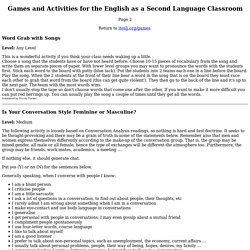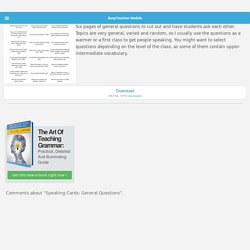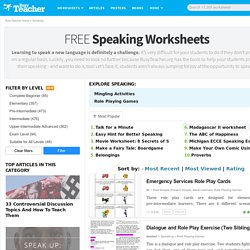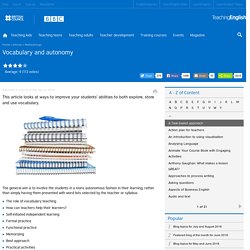

All Things Topics - Home. Animals and Birds. ESL Conversation Questions. Speak in English online - best way to improve English. Games & Activities for the ESL/EFL Classroom - Page 2(I-TESL-J) Games and Activities for the English as a Second Language Classroom Page 2 Return to iteslj.org/games.

Word Grab with Songs Level: Any Level This is a wonderful activity if you think your class needs waking up a little. Is Your Conversation Style Feminine or Masculine? Level: Medium The following activity is loosely based on Conversation Analysis readings, so nothing is hard and fast doctrine. If nothing else, it should generate chat. Put yes (Y) or no (N) for the sentences below. Generally speaking, when I converse with people I know: 4, 6, 8, 9, 12, 14, 16, 18 and 21 would be more feminine traits-generally speaking The rest, male. Once again, the activity should not give rise to aggressive exchanges. A Conversation Idea - Rate the Apparatus Activity A. English Conversations - English Conversation Recordings. ESL Conversation Questions - Small Talk (many random questions) Basic Conversation Qs (beg / preint) These worksheets can be used as a speaking activity.

Students work in pairs and take turns in asking the questions. It's good if you as a teacher to circulate and monitor their work. At the end, highlight any mistakes that you heard. The two blank cicrcles should be filled in with students' own questions to ask each other. The second worsheet is more challenging as it requires more grammar knowledge. Not available in mobile version. The Art Of Teaching Grammar: Practical, Detailed And Illuminating Guide. Conversation (with cards) Random questions: busyteacher. Six pages of general questions to cut out and have students ask each other.

Topics are very general, varied and random, so I usually use the questions as a warmer or a first class to get people speaking. You might want to select questions depending on the level of the class, as some of them contain upper-intermediate vocabulary. The Art Of Teaching Grammar: Practical, Detailed And Illuminating Guide.
Describing photos (comparing, contrasting and speculating) You are going to practise language for; Describing photosComparing and contrasting photos (discussing similarities and differences)Speculating on what might be happeningReacting to photos (giving opinions) Discuss Look at the presentation.

Follow the instructions and talk about some of the photos Write The language used here for comparing and contrasting / speculating is also useful for writing discussion / argument essays. Plan: Introduction - describe the situation / topic to be discussedCompare / contrast ideas (for and against / advantages and disadvantages)Speculate on solutions to problems raised by the questionConclusion - give an opinion Which pairs or groups of photos in the presentation could be used to demonstrate ideas for argument writing topics about education, technology, food, family, work, leisure, health, advertising etc?
50 random questions - Random Discussion. At my house on the far side of shelton. at the risk of sounding conceited, i am learning to love myself. but so far nobody else has deemed it a worthy thing to enter my life and brighten it. no, but i remember as a child reading about a dog who ate a pack of crayons and crapped bundles of multicolored turds all over the lawn of its owner. there is an old weathered sun-faded red leather couch which has faded to the same kind of pink as an old sick cow. i honestly can't remember, it has been so long. no, just fuzzy slippers. yes, but not by much.

Conversation Topic Generator. 705 FREE Speaking Worksheets. Learning to speak a new language is definitely a challenge.

It’s very difficult for your students to do if they don’t practice on a regular basis. Luckily, you need to look no further because BusyTeacher.org has the tools to help your students practice their speaking - and want to do it, too! Let’s face it, students aren’t always jumping for joy at the opportunity to speak a language they aren’t 100 percent comfortable with. Students can be hesitant to speak for a wide variety of reasons - fear of mistakes, peer pressure, or lack of self-confidence are some of the main factors. Language In Use. It is great to show and offer students many examples of English language in use.

Meaning, students appreciate that there are many ways to say the same thing and like to see the "nuance" of the English language. Here are some images showing different ways / expressions to communicate a similar thing. Might be handy. Also, view as a slideshow or you can purchase and edit in ppt. If interested in this kind of approach, you might be interested in my ebook "Get TALKing" which has 28 lessons all based around language chunks. WORD GAMES. Vocabulary and autonomy. The general aim is to involve the students in a more autonomous fashion in their learning, rather than simply having them presented with word lists selected by the teacher or syllabus.

The role of vocabulary teachingHow can teachers help their learners? Self-initiated independent learningFormal practiceFunctional practiceMemorizingBest approachPractical activitiesReferences The role of vocabulary teachingIn the context of learning English as a foreign language, a learner is forced to be autonomous and independent and make conscious effort to learn vocabulary outside the classroom simply because the exposure to the target language is limited in class. So teachers cannot rely on their Ss 'picking up' lexical items. This makes explicit vocabulary teaching necessary. How can teachers help their learners? Self-initiated independent learningThese strategies involve planned, active and motivated learning and exposure to language outside the classroom (media).
Medical English for doctors and patients, pharmacists, etc. Speaking Exercises. Conversation Topic Generator.